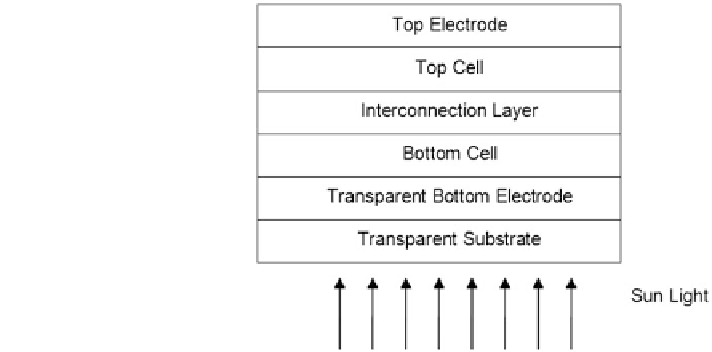Environmental Engineering Reference
In-Depth Information
Fig. 3.2 Schematics of
common double junction
tandem solar cell device
structure
3.4 Interface Engineering for Organic Tandem
Solar Cell Devices
To improve the absorption of the sunlight photons by organic solar cells, active
materials with a broader absorption spectrum have to be designed. This is generally
achieved by reducing the band gap of the material which could lead to lower V
OC
in
the devices. Another strategy is to apply tandem device structure in which multiple
absorbers with different band gaps are to be stacked or mixed in multiple junctions.
When two or more donor materials with nonoverlapping absorption spectra are used
in a tandem solar cell, broader range of the solar spectrum can be covered without
sacrificing V
OC
of the device, as the thermalization of hot carriers can be minimized
[
135
]. The most commonly employed tandem cell structure is a two terminal
monolithic device in which two subcells are connected in series through an inter-
connecting layer (ICL), as shown in Fig.
3.2
. Several approaches for organic tan-
dem cells have been reported in recent years, depending on the materials used for
the active layer and the respective interconnection layers. In general, the organic
tandem solar cells can be divided into three classes [
136
]: (1) Tandem organic solar
cells in which low-molecular-weight molecules are used for both the bottom and the
top cells; (2) Hybrid tandem organic solar cells in which the bottom cell is pro-
cessed from polymers by solution-processing, while the top cell is made of vacuum-
deposited low-molecular-weight molecules; (3) Fully solution-processed tandem
organic solar cells in which both the bottom and the top cells are BHJ-PSCs. The
third class of organic tandem solar cells began to receive enormous attentions since
Kim et al. successfully fabricated an all solution-processed (except the cathode)
tandem cell device with a record efficiency of 6.5 % in 2007 [
12
]. The interface
problems in such tandem solar cell devices are much more complicated than single
junction devices, as more layers are incorporated into a single device.
The ICL, both physically and electrically, connects the two subcells in an
organic tandem solar cell device and it is critical in the fabrication of highly

Search WWH ::

Custom Search